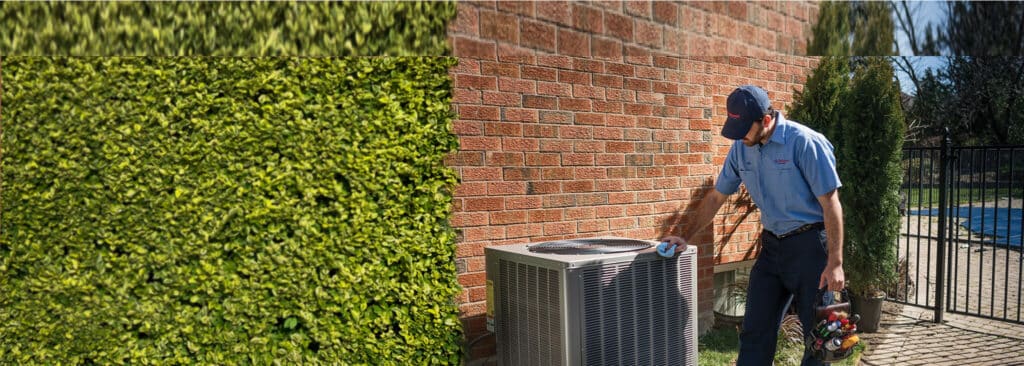The heating and cooling industry has its own unique set of words and terms. Take a few moments to review the following and you’ll be speaking HVAC in no time!
Air Conditioner or AC
Equipment that is designed to lower the temperature in a room or building.
Air Flow
The amount of air that is being moved through an HVAC system. Usually measured in cubic feet per minute (CFM).
Air Handler
An air handler, which resembles a large metal box, is the indoor part of an HVAC system that moves heated or cooled air throughout the home.
Blower
The part of an air handler or furnace that pushes the air throughout the home.
Central Air Conditioner System
A system that cools and then distributes air to and from rooms by fans and a system of ducts.
Checking the Charge
Describes the process of identifying if the AC has an appropriate amount of refrigerant. Charging the AC means adding refrigerant to the system.
Compressor
An AC or heat pump compressor is the outdoor part of an air conditioner or heat pump that compresses the refrigerant and pumps it through the system.
Condensate
Moisture removed from the air in a home when it is cooled below its dew point.
Condenser
An AC condenser is the outdoor portion of an air conditioner or heat pump that releases or collects heat.
Condenser Coil
A series of tubes and fins containing refrigerant, resembling a car radiator, that is found in the condenser.
Cooling Capacity
A measure of an AC’s ability to remove heat from an enclosed space, as measured by BTU’s or Tons.
Cubic Feet Per Minute (CFM)
A measurement of airflow volume, determined by how many cubic feet of air pass by a stationary point in one minute.
Ductless Mini-Split Air Conditioner
Designed to work without a duct system, the unit’s blower and evaporator coil are in the head, which is mounted on a wall, ceiling or floor of the room to be cooled. This is the most common type of air conditioner outside of North America.
Ductwork
The system of ducts used to distribute heated or cooled air to various rooms and floors of a home. A duct system that is properly installed and well-maintained plays an important role in good indoor air quality and home comfort.
Electronic Air Cleaner
Also known as electronic air purifiers, electronic air cleaners use electrically charged filters to attract and trap airborne contaminants.
Energy Star®
The ENERGY STAR initiative is a voluntary partnership between the Government of Canada and industry to promote energy efficiency. Simply by looking for the ENERGY STAR symbol, Canadians can easily identify energy efficient products and new homes.
Energy Efficiency Ratio (EER)
Describes an air conditioner’s cooling efficiency. It is calculated by taking the BTUs per hour of the system divided by the total electrical energy consumed.
Evaporator Coil
Located near the air handler or furnace, the evaporator coil is the part of an air conditioner or heat pump that absorbs or releases heat inside the home.
Heat Pump
A heat pump is an HVAC unit that either heats, or cools by moving heat, depending on the season. In the summer, for instance, it removes heat from the home and releases it outdoors.
Humidifier
A humidifier is equipment that adds moisture to a living space. Humidifiers may use the fan in the furnace or air handler to blow humidified air, or in the case of individual rooms, could be standalone units.
HVAC
Heating, Ventilation and Air Conditioning.
HVAC Zoning System
An HVAC zoning system is a heating and cooling system that uses dampers or valves to heat or cool only designated areas of the home for enhanced comfort.
Packaged Air Conditioner/Unit
A heating and cooling system contained in one outdoor cabinet.
Programmable Thermostat
A thermostat that gives users the ability to adjust home temperature according to a pre-set schedule.
R-22 Refrigerant
The old standard refrigerant for residential air conditioners, also known as freon, now being phased out industry-wide.
R-410A Refrigerant
The current standard for refrigerant. R-410A is chlorine-free.
Refrigerant
A fluid used in air conditioners and heat pumps to transfer heat to and from the home.
Refrigerant Lines
Two lines that connect the outdoor air conditioner or heat pump to the indoor evaporator coil.
Seasonal Energy Efficiency Ratio (SEER)
An energy efficiency rating for air conditioners. The higher the SEER, the more efficient the unit.
Split System HVAC
A heating and cooling system that includes an indoor unit, outdoor unit and a thermostat. Most AC systems in Canada are split systems.
Thermostat
A device that monitors the indoor temperature and automatically adjusts the heating or cooling system to maintain the desired level.
Tonnage
The unit of measure used in air conditioning to describe the cooling capacity of a system.
Variable Speed Motor
A motor that operates at a range of speeds to control the distribution of heated and cooled air throughout the home.
Ventilator
A ventilator replaces stale air in a home with filtered outdoor air.
If you ever have a problem that requires in-home service, our expert technicians are only a phone call away. Just Call on Reliance®.








